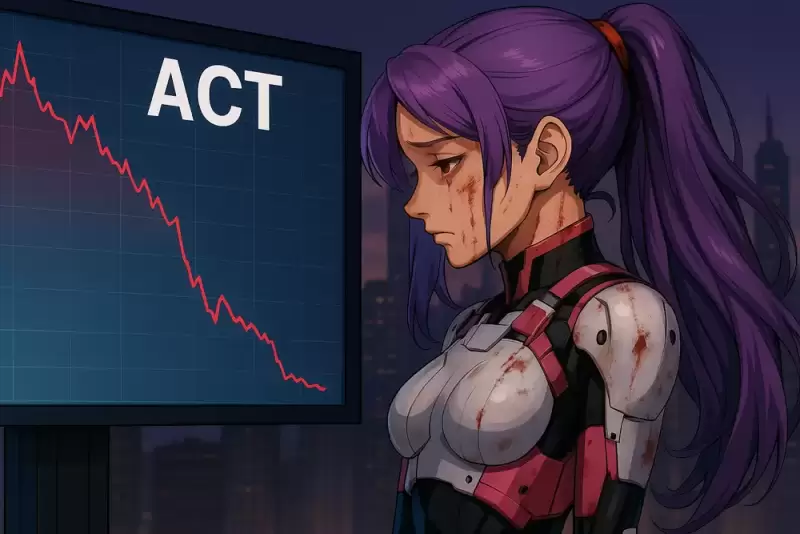 |
|
 |
|
 |
|
 |
|
 |
|
 |
|
 |
|
 |
|
 |
|
 |
|
 |
|
 |
|
 |
|
 |
|
 |
|
Cryptocurrency News Articles
Binance's Routine Contract Rule Adjustment Accidentally Exposed the Most Vulnerable Pimple in the Crypto Market
Apr 02, 2025 at 09:33 am
A routine contract rule adjustment by Binance accidentally exposed the most vulnerable pimple in the crypto market.

On April 1, a routine adjustment of contract rules by Binance accidentally exposed the most vulnerable pimple in the crypto market. Within half an hour, low-market-cap tokens such as ACT collectively saw their values halved, putting the fatal flaws of exchange risk control mechanisms, market maker algorithm strategies, and the MEME coin ecosystem in the spotlight.
Although Binance responded urgently and blamed “large investors selling”, the 75% evaporation of contract holdings, the precise synchronization of multi-currency price fluctuations, and the mysterious operation of market maker Wintermute selling on the chain after the crash all exposed deeper industry risks in this Rashomon incident - in the current weak liquidity, exchanges’ attempts to repair systemic risks may become the last straw that breaks the camel's back.
Multiple tokens collectively halved in half an hour
At 15:32 on April 1, Binance released an announcement on adjusting the leverage and margin tiers of multiple U-margin perpetual contracts, involving several trading pairs such as 1000SATSUSDT, ACTUSDT, PNUTUSDT, NEOUSDT, and NEOUSDC. The content of this adjustment mainly adjusts the position limit and leverage margin ratio of contract transactions of these tokens. Taking ACT as an example, the maximum position limit before the adjustment was 4.5 million US dollars, and after the adjustment it was reduced to a maximum of 3.5 million US dollars. The adjustment time shown in the announcement is 18:30.
At 18:30 on the same day, ACT fell from $0.1899 to $0.0836 in 36 minutes, a drop of 55%, triggering heated discussions in the market.
Almost at the same time as ACT, TST, HIPPO, DEXE, PNUT and other low-market-cap tokens on Binance all experienced flash crashes to varying degrees, with declines generally ranging from 20% to 50%. Market data showed that 18:30 was the starting point for the steep decline in prices of multiple tokens, affecting a wider range than a single project, showing obvious synchronization.
Specifically, this adjustment is to reduce the maximum position size that can be held under the leverage multiple. For example, you used to be able to hold tokens worth $1 million with a certain leverage, but now the rules have changed and you may only be able to hold a maximum of $800,000. If the user does not actively close the position, the system will force the excess position to be closed at the market price when the rule takes effect. Therefore, the contract price will drop sharply in a short period of time, which will then trigger a stampede.
This has sparked a lot of discussion on social media. @terryroom2014 pointed out that "the open interest of Binance contracts dropped sharply at 18:30, and the exchange took the initiative to cut off large positions, causing the price to collapse"; @yinshanguancha believed that "market makers were forced to close their positions due to insufficient margin, and the rule adjustment was the trigger." Most users pointed the finger at Binance's rule adjustment, believing that the reduction of the position limit triggered the forced liquidation, which in turn triggered panic selling and market stampede effects.
Some users also speculated that this was due to the active dumping of ACT by market makers. @Web3Tinkle pointed out that the amount of ACT held on Binance dropped by 73 million US dollars in just 15 minutes, implying that the project party and market makers instantly sold out and harvested the market.
In response to this, He Yi, the co-founder of Binance, said during an interaction on the X platform that when asked whether the ACT plunge was caused by Binance's modification of the contract rules, He Yi responded that "the team is preparing to respond with details."
About 2 hours later, Binance released a preliminary investigation report on the incident, which stated that the decline in ACT was mainly due to the sale of about $1.05 million in spot tokens by three VIP users and one non-VIP user in a short period of time, which caused the price to fall and led to the decline of other tokens. In summary, Binance's response believed that the main reason for this short-term plunge was the selling of large investors, rather than Binance's adjustment of rules.
Are exchanges overdoing risk control or are market makers clearing their positions to protect themselves?
This market crash reminds people of the recent Hyperliquid lightning attack. On March 26, the decentralized exchange Hyperliquid encountered a trader who exploited a liquidity design loophole and dumped a huge amount of short orders to the platform by withdrawing margin, which almost caused a loss of more than 10 million US dollars to the Hyperliquid vault.
Perhaps warned by the Hyperliquid incident, Binance tried to control risks by lowering the contract
Disclaimer:info@kdj.com
The information provided is not trading advice. kdj.com does not assume any responsibility for any investments made based on the information provided in this article. Cryptocurrencies are highly volatile and it is highly recommended that you invest with caution after thorough research!
If you believe that the content used on this website infringes your copyright, please contact us immediately (info@kdj.com) and we will delete it promptly.
-

-

- KuCoin Launches Licensed Cryptocurrency Exchange in Thailand to Expand Its Southeast Asian Market
- Apr 25, 2025 at 09:15 am
- In a major move, KuCoin has officially launched a licensed cryptocurrency exchange in Thailand. The exchange takes an important stride toward its Southeast Asian market expansion through this decision.
-

-

- Robert Kiyosaki unleashes a seismic forecast, predicting a Great Depression while urging bold bets on bitcoin
- Apr 25, 2025 at 09:10 am
- Robert Kiyosaki, author of the best-selling book Rich Dad Poor Dad, has once again warned of deepening financial instability in the U.S., while urging individuals to take control of their economic futures through strategic investments.
-

-

-

-

-

- POPCAT (POPCAT) is showing early signs of life as it presses against a level it hasn't cleared in over two months
- Apr 25, 2025 at 08:55 am
- POPCAT is showing early signs of life as it presses against a level it hasn't cleared in over two months. But can this altcoin finally shift momentum and kickstart a fresh trend?




























































